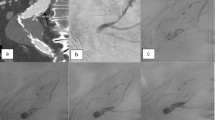Abstract
Purpose
To determine the feasibility and efficacy of transarterial endoleak embolization using the liquid embolic agent ethylene vinyl alcohol copolymer (Onyx).
Methods
Over a 7-year period eleven patients (6 women, 5 men; mean age 68 years, range 37–83 years) underwent transarterial embolization of a type II endoleak after endovascular aortic aneurysm repair using the liquid embolic agent Onyx. Two patients (18 %) had a simple type II endoleak with only one artery in communication with the aneurysm sac, whereas 9 patients (82 %) had a complex type II endoleak with multiple communicating vessels. We retrospectively analyzed the technical and clinical success of transarterial type II endoleak embolization with Onyx. Complete embolization of the nidus was defined as technical success. Embolization was considered clinically successful when volume of the aneurysm sac was stable or decreased on follow-up CT scans.
Result
Mean follow-up time was 26.0 (range 6–50) months. Clinical success was achieved in 8 of 11 patients (73 %). Transarterial nidus embolization with Onyx was technically successful in 6 of 11 patients (55 %). In three cases the nidus was embolized without direct catheterization from a more distal access through the network of collateral vessels.
Conclusion
Onyx is a favorable embolic agent for transarterial endoleak embolization. To achieve the best clinical results, complete occlusion of the nidus is mandatory.




Similar content being viewed by others
References
Nevala T, Biancari F, Manninen H et al (2010) Type II endoleak after endovascular repair of abdominal aortic aneurysm: effectiveness of embolization. Cardiovasc Intervent Radiol 33:278–284
Jones JE, Atkins MD, Brewster DC et al (2007) Persistent type 2 endoleak after endovascular repair of abdominal aortic aneurysm is associated with adverse late outcomes. J Vasc Surg 46:1–8
Solis MM, Ayerdi J, Babcock GA et al (2002) Mechanism of failure in the treatment of type II endoleak with percutaneous coil embolization. J Vasc Surg 36:485–491
Higashiura W, Greenberg RK, Katz E et al (2007) Predictive factors, morphologic effects, and proposed treatment paradigm for type II endoleaks after repair of infrarenal abdominal aortic aneurysms. J Vasc Interv Radiol 18:975–981
van Marrewijk CJ, Fransen G, Laheij RJ et al (2004) Is a type II endoleak after EVAR a harbinger of risk? Causes and outcome of open conversion and aneurysm rupture during follow-up. Eur J Vasc Endovasc Surg 27:128–137
Schlosser FJ, Gusberg RJ, Dardik A et al (2009) Aneurysm rupture after EVAR: Can the ultimate failure be predicted? Eur J Vasc Endovasc Surg 37:15–22
White RA, Donayre C, Walot I, Stewart M (2000) Abdominal aortic aneurysm rupture following endoluminal graft deployment: report of a predictable event. J Endovasc Ther 7:257–262
Baum RA, Carpenter JP, Tuite CM et al (2000) Diagnosis and treatment of inferior mesenteric arterial endoleaks after endovascular repair of abdominal aortic aneurysms. Radiology 215:409–413
Kato N, Semba CP, Dake MD (1996) Embolization of perigraft leaks after endovascular stent-graft treatment of aortic aneurysms. J Vasc Interv Radiol 7:805–811
Stavropoulos SW, Park J, Fairman R, Carpenter J (2009) Type 2 endoleak embolization comparison: translumbar embolization versus modified transarterial embolization. J Vasc Interv Radiol 20:1299–1302
Wilmot A, Stavropoulos SW (2007) Embolization of a recurrent type 2 endoleak using the liquid embolic n-butyl cyanoacrylate. Semin Intervent Radiol 24:38–42
Ling AJ, Pathak R, Garbowski M, Nadkarni S (2007) Treatment of a large type II endoleak via extraperitoneal dissection and embolization of a collateral vessel using ethylene vinyl alcohol copolymer (Onyx). J Vasc Interv Radiol 18:659–662
Martin ML, Dolmatch BL, Fry PD, Machan LS (2001) Treatment of type II endoleaks with Onyx. J Vasc Interv Radiol 12:629–632
Chaikof EL, Blankensteijn JD, Harris PL et al (2002) Reporting standards for endovascular aortic aneurysm repair. J Vasc Surg 35:1048–1060
Baum RA, Carpenter JP, Golden MA et al (2002) Treatment of type 2 endoleaks after endovascular repair of abdominal aortic aneurysms: comparison of transarterial and translumbar techniques. J Vasc Surg 35:23–29
Stavropoulos SW, Kim H, Clark TW et al (2005) Embolization of type 2 endoleaks after endovascular repair of abdominal aortic aneurysms with use of cyanoacrylate with or without coils. J Vasc Interv Radiol 16:857–861
Mansueto G, Cenzi D, D’Onofrio M et al (2005) Treatment of type II endoleaks after endovascular repair of abdominal aortic aneurysms: transcaval approach. Cardiovasc Intervent Radiol 28:641–645
Bailey MA, McPherson SJ, Troxler MA et al (2011) Ischemic skin ulceration complicating glue embolization of type II endoleak after endovascular aneurysm repair. J Vasc Interv Radiol 22:163–167
Forester ND, Parry D, Kessel D et al (2002) Ischaemic sciatic neuropathy: an important complication of embolisation of a type II endoleak. Eur J Vasc Endovasc Surg 24:462–463
Stone JR, Evans AJ, Angle JF et al (2009) In vitro assessment of aortic stent-graft integrity following exposure to Onyx liquid embolic agent. J Vasc Interv Radiol 20:107–112
Chaloupka JC, Vinuela F, Vinters HV, Robert J (1994) Technical feasibility and histopathologic studies of ethylene vinyl copolymer (EVAL) using a swine endovascular embolization model. AJNR Am J Neuroradiol 15:1107–1115
Conflict of interest
The authors declare that they have no conflict of interest.
Author information
Authors and Affiliations
Corresponding author
Rights and permissions
About this article
Cite this article
Müller-Wille, R., Wohlgemuth, W.A., Heiss, P. et al. Transarterial Embolization of Type II Endoleaks after EVAR: The Role of Ethylene Vinyl Alcohol Copolymer (Onyx). Cardiovasc Intervent Radiol 36, 1288–1295 (2013). https://doi.org/10.1007/s00270-013-0567-5
Received:
Accepted:
Published:
Issue Date:
DOI: https://doi.org/10.1007/s00270-013-0567-5




